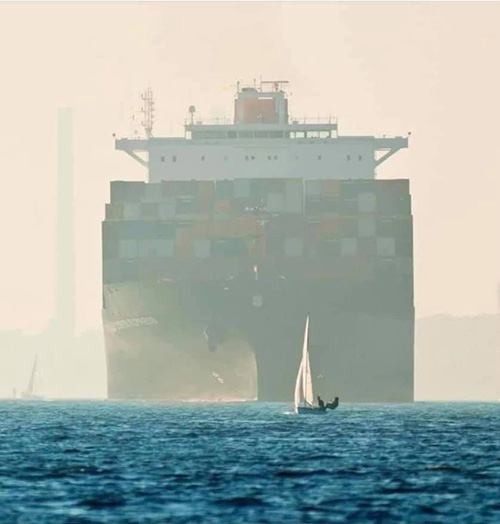
Photos like this get posted in boating discussion groups with some regularity. The discussion goes like this — Although the sailing vessel has ‘right of way,’ it would be prudent for the sailing vessel to move out of the way of the cargo vessel.
This discussion is misguided. Firstly, there is no ‘right of way’ in the rules of the road. Instead, there is a ‘stand on’ and ‘give-way’ vessel. This means that the stand on vessel is required to stay on her course, and the give-way vessel is required to take action to avoid a collision. Only under certain circumstances will the stand-on vessel will be expected to change course. In other words, if the stand-on vessel takes action too soon, and that action results in a collision, the stand-on vessel, the one that many confuse as the one having ‘right of way’ can be considered to have some fault.
Secondly, sailboats do not have ‘priority’ over motor vessels at all times. The regulations does say that if a possibility of a collision exists between a motor driven vessel and a sailing vessel, the sailing vessel is the stand-on vessel. However, when other circumstances exist, this is no longer true. Here is a list of vessels that have ‘priority’ over a sailing vessel underway.
-Vessels not under command (ex: ships with mechanical problems)
-Vessels restricted in ability to maneuver (ex: ships towing a large load)
-Vessels constrained in draft
-Vessels engaged in fishing or trawling (does not include recreational angling)
-Vessels not underway
-Vessels being passed from abaft of the beam (vessels being passed from behind by another vessel)
In this particular example, the cargo vessels seem to be near land, which means that she is likely underway in a dredged shipping channel. This limits her movements to the confines of the channel, making her a vessel constrained by her draft. Thus, the cargo vessel in this photo is actually the stand-on vessel, and the sailing vessel must take action as soon as possible to avoid the possibility of a collision. Now that you know this, what is the lesson here?
If so many people who hold themselves out as boating enthusiasts do not understand the rules of the road, then you cannot count on them to practice safe boating. It is up to us as boat operators (recreational and professional alike) to maintain vigilant watch.
Don’t be in this situation to begin with. Make your course adjustments early on, before any possibility of collision exist, regardless of who would be the stand-on vessel if a situation develops.
-Captain Jerry
www.reflectionsdc.com